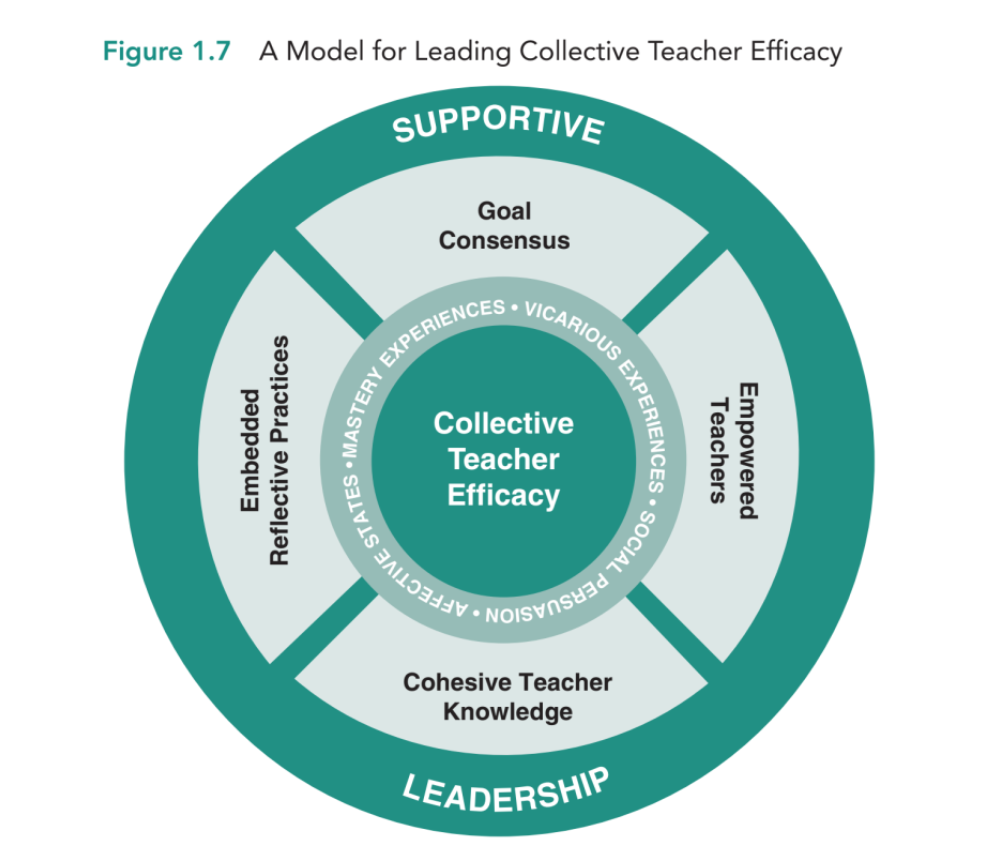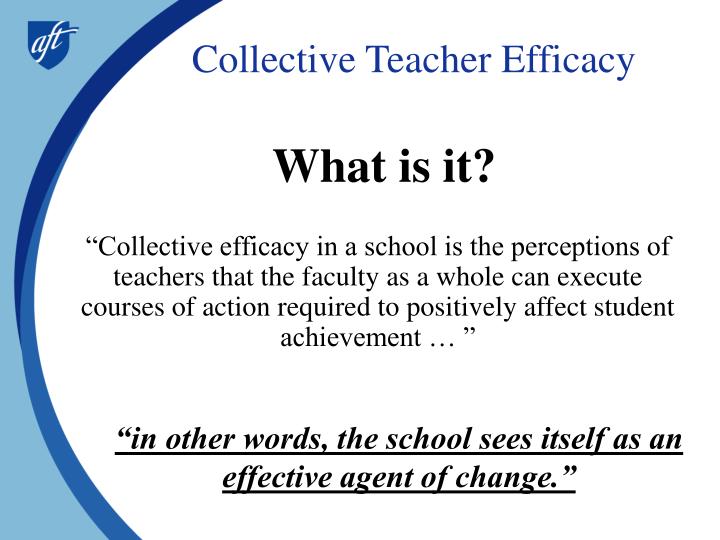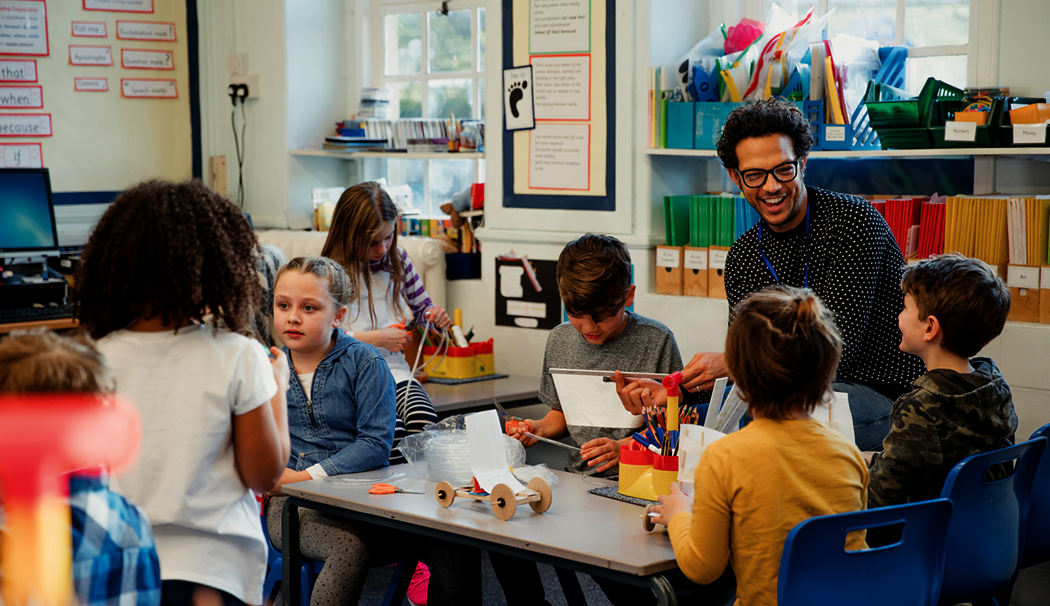
Leading Our Schools into the Future with Collective Efficacy A+ Alabama Best Practices Center
Four sources of collective teacher efficacy The formation of collective teacher efficacy builds on the model of self-efficacy formulated by Bandura. Collective teacher efficacy is an attribute at the group level. Goddard defines collective efficacy as, "the perceptions of teachers in a school that the faculty as a whole can organize and execute the courses of action required to have a.

Leading Learning Matters
By the turn of the century, collective teacher efficacy had been operationalized, and instruments had been developed to measure it (Goddard, 2002). Models for collective efficacy in schools have been tested and refined, with researchers finding that as successes and support strengthen teachers' confidence in their teams, student achievement increases as well (Goddard, Hoy, & Woolfolk Hoy, 2004.

The Teacher Credibility and Collective Efficacy Playbook, Grades K12 ALRAN Books
Collective teacher efficacy, the perceptions of teachers in a school that the efforts of the faculty as a whole will have a positive effect on students, is based on Bandura's (1977, 1986, 1997) social cognitive theory, a unified theory of behavior change. Social cognitive theory is concerned with human

Collective Teacher Efficacy PD Mosaic
Little is known about how teacher professional development helps enhance collective teacher efficacy so as to improve student performance. The present systematic review addresses two research questions, first by identifying 583 studies that may contribute pertinent information and then by performing in-depth analysis to eliminate those that did not meet our inclusion and quality criteria.

Collective Teacher Efficacy & Credibility with Students The four types of teachers YouTube
The body of collective teacher efficacy (CTE) research has developed considerably since Goddard referred to the school-level factor as a "neglected construct" in the study of schools and.

What is Collective Teacher Efficacy (CTE)? Superhero teacher, Teacher time savers, Teacher
Attending to these three enabling conditions will help in realizing the possibility of collective teacher efficacy in schools. #1. Advanced Teacher Influence. There is a clear and strong relationship between collective efficacy and the extent of teacher leadership in a school (Derrington & Angelle, 2013; Goddard, 2002; Knobloch, 2007). Advanced.

PPT Collective Efficacy PowerPoint Presentation ID4462907
Collective teacher efficacy is "the collective self-perception that teachers in a given school make an educational difference to their students over and above the educational impact of their homes and communities" (Tschannen-Moran & Barr, 2004, p. 190).Collective teacher efficacy finds its roots in social cognitive theory, as it has evolved from studies on individual teacher efficacy.

Collective Teacher Efficacy Good Conditions for Schools TeacherToolkit
Make an impact with your research, publish with Routledge today. Education 3-13 | Taylor & Francis Online

Collective Teacher Efficacy Teaching Channel
Benefit #4: Collective teacher efficacy is often stronger in schools with co-taught classrooms where: • practice is less private when teachers plan, teach, debrief and reflect together • the co-teaching cycle encourages teachers to collaboratively evaluate their impact on learning • co-teachers can support and validate one

Advanced Collaborative Solutions Steve Ventura Education Blog
Collective teacher efficacy happens when teachers have "influence over instructionally relevant school decisions" (Goddard et al., 2004), and that certainly didn't seem to be happening. Within our school, I began to hear teachers express concerns about low morale—a sign for me that teachers didn't feel they were meaningfully engaged in their work.

The importance of building collective teacher efficacy
Collective teacher efficacy refers to "the judgments of teachers in a school that the faculty as a whole can organize and execute the courses of action required to have a positive effect on students" (Goddard, Hoy, & Woolfolk Hoy, 2004, p. 4). Collective efficacy is high

Three Keys to Creating Teachers’ Collective Efficacy Serendipity in Education
The existing literature provides compelling evidence on the effect of school leadership on the collective efficacy of teachers, which is highly correlated with teaching-learning outcomes. However, the results of studies that examined the relationship between these variables have not reached a consensus. Therefore, the main objective of this study is to determine the extent to which school.

What is Collective Teacher Efficacy? Taking A Partnership Approach to Help Students Shine
Collective Teacher Efficacy is the collective belief of teachers in their ability to positively affect students. With an effect size of d=1.57 Collective Teacher Efficacy is strongly correlated with student achievement. Here is a quick overview of John Hattie's "new number one" influence.

Collective Teacher Efficacy Supports Multilinguals’ Success
A Free Online Refresher Course For Teachers Of Children & Young People - With Certificate. Recognized And Prize-Winning Courses Provided Online And For Free - Since 2007.

What is Collective Teacher Efficacy (CTE)? A Definition Gradecam
The Collective Efficacy Scale (CE scale; [47]) measures collective teacher efficacy in a group within a school. The CE scale has 21 items that are measured using a 6-point Likert scale, with 1.

Visible Learning John Hattie’s Research on Student Achievement Success in the Classroom
Collective teacher efficacy (CTE) beliefs serve to encourage certain behaviours and constrain others. Bandura (Educ Psychol 28(2):117-148, 1993) was the first to generate interest in this area by demonstrating that the effect of perceived CTE on student achievement was stronger than the link between socio-economic status and student achievement. The purpose of this study was to gain a better.